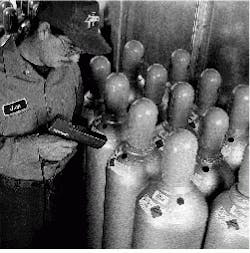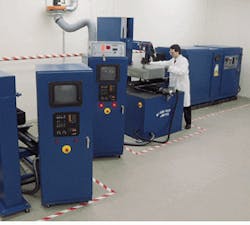Pay attention to detail to realize laser gas benefits
Gas lasers were one of the first laser types to be demonstrated. Now there are a variety of gas lasers available with a wide range of performance characteristics. With variations in pressure and gas composition, including noble gases, complex molecules, and even metal vapors, gas lasers are capable of lasing at a multitude of wavelengths throughout the spectrum. The large number of gas-laser types stems directly from the relative ease in emptying and filling laser tubes for laser operation.
While solid-state and semiconductor lasers have replaced gas lasers for many applications, gas lasers remain important in several areas. Many shorter visible wavelengths are produced by gas lasers in standard configurations. And the classic helium-neon laser continues to introduce generations of students to the laser and to register purchases via barcode scanning at the local store. But the most important market segments, in terms of dollar volume, are gas lasers for industry and medicine—high-power carbon dioxide (CO2) infrared lasers are standard for welding, cutting, and marking, and halogen-gas ultraviolet excimer lasers are realizing an explosive increase in medical applications and industrial work.
This Product Focus gives a representative overview of laser gases and their handling issues with emphasis on the industrial and medical types. The table that follows on p. 99 lists some of the companies providing laser gases and handling equipment; it is not meant to be a comprehensive inventory. For such a supplier listing see the 1995 Laser Focus World Buyers Guide, p. 254. Prospective buyers should contact individual vendors for complete details of their product line, selection criteria, and handling tips that are often found in their catalogs.
Just another utility?
The nature and familiarity of laser gases contribute to their usefulness but may also foster a lack of awareness of specific handling nuances and precautions for individual gases. The presence of industrial gases in the workplace tends to cause them to be regarded as just another utility such as water and electricity, according to BOC Gases (Murray Hill, NJ) director of special gases Richard Betzendahl. He notes that gas-industry concerns revolve around safety and cost in addition to the required mixture precision and purity.
Safety is always important with pressurized gas containers in general, and especially so with toxic and corrosive halogen mixtures for excimer lasers. Still, the largest number of gas-handling accidents involve the mundane task of moving and handling gas cylinders (see Fig. 1).
But the potential hazards of excimer gases should not be underestimated. “The biggest problem we find is the user who doesn’t understand the hazard of, for example, a fluorine premix because the cylinder says ‘nonflammable,’” says Eric Soderlund, director of marketing for Nova Gas Technologies (formerly Cryogenic Rare Gas, Charleston, SC). Such official Department of Transportation labeling tends to make some customers feel safer in regard to fire and explosion potential, but may impart a false sense of security as to other dangers.
The hazards of hydrogen chloride excimer gas include its affinity for water, with which it forms hydrochloric acid. The colorless, pungent gas, even in its usual 5% excimer mixture concentration with an inert gas, is corrosive and causes severe burns when it contacts skin. Fluorine is even nastier; it is hazardous in concentrations as low as
0.1 ppm, 50 times less than the limit for hydrogen chloride. Pale yellow and ozone-smelling, fluorine, the strongest oxidizing agent, reacts violently with water and organic materials. Not only does tissue corrosion take place when fluorine comes in contact with skin, but internal blood and heart damage can result from fluorine exposure.
Purity is fundamental
Laser-gas customers need to know about specific measures that must be taken for these gases to maintain high purity, not just for laser performance, but to minimize degradation to the laser optics. Unscheduled repairs result in costly downtime, BOC’s Betzendahl says, which is of great concern to industrial-laser users. And while high gas purity necessary for efficient lasing is a prime consideration, equally important is the nature of the few impurities that are present in very clean laser mixtures. “Even the smallest amount of hydrocarbons will degrade CO2 laser optics,” he adds.
“Gases have to maintain their integrity from the cylinder to the laser,” says Betzendahl, which is why it is desirable to place the gas supply as close to the laser as possible to minimize fill distance and contamination potential. For excimer-laser fill systems, only stainless-steel or copper tubing should be used. This tubing must first be properly passivated by filling and flushing several times with halogen gas to form a metal-halide layer on the tube walls (see Laser Focus World, Sept. 1993, p. 125). The layer renders the wall inert to resist corrosion and seals it to limit gas penetration along microscopic metal-grain boundaries.
Stainless-steel regulators are also needed in halogen-gas supply systems to sustain gas purity. The regulator seals, which are usually Teflon, are also important. Even CO2 laser supplies require similar attention. According to Betzendahl, in the past, some CO2 laser users have thought a contaminated tank caused degraded laser performance. In fact, neoprene regulator seals or rubber hoses feeding the laser outgassed hydrocarbons, destroying the laser optics.
Not only are gases used for lasing; they can be used in conjunction with other aspects of industrial-laser processing that involve solid-state Nd:YAG lasers. Helium, nitrogen, or CO2 can shield workpieces from atmospheric interactions, such as helium for high-integrity welding; oxygen or nitrogen-oxygen mixtures can reduce laser cutting times or permit cleaner cuts in metals. In these processes maintaining the gas-purity level is important for obtaining consistent results.
Cylinder care
Perhaps the most critical component of a laser-gas system is the gas cylinder in which the gas resides until used. The internal treatment of the container is critical for gas lifetime, particularly for excimer halogens. For these and other reactive gases, cylinder walls can be passivated, or ‘pickled,’ with gas or electroplated to form a nonreacting layer. Fluorine tanks are passivated and hydrogen chloride tanks are nickel plated. Tanks must be polished inside before passivation to eliminate roughness that can cause particle shedding. A tank that is not polished and plated can retain moisture within microcracks in the wall.
Gas tanks should be housed in a vented cabinet specifically designed to store and supply the gas. A cabinet control panel can allow manual or automatic operation of the gas-handling systems including supply and purging. The cabinet facilitates purging and permits the laser to be housed close to the gas, while isolating the gas supply from the laboratory or production area, lowering contamination potential. Safety systems such as fire extinguishers also can be incorporated into the cabinet. After removal from the cabinet, ‘empty’ tanks still contain some gas and must be handled with appropriate care
In recent years, halogen-gas generation at the laser has been introduced to reduce the risks in handling excimer gases. A volume of gas sufficient to recharge the laser is generated close to the laser as needed with the required purity. Lambda Physik (Acton, MA) manufactures a generator that can be incorporated into a laser housing and can be retrofitted to previously produced lasers. The generator holds sufficient reactants for operation for several months to several years (in the case of xenon chloride) and can be recharged by replacing a cylinder within the housing.
For fluorine excimer lasers, the generator cartridge contains ceramic cylinders with embedded fluorine forming a nonhazardous compound. When the laser microprocessor signals that a recharge is needed, the cartridge is heated to give off enough gas to fill the laser. At room temperature, the remaining gaseous fluorine is reabsorbed into the ceramic. For hydrogen chloride, two harmless liquids are gasified and mixed in the proper amount for refilling the laser cavity.
Sal Balsamo, Lambda Physik regional sales manager, says generated gas purity is higher than needed to run a laser. He says that the system is being ordered by new laser operators, and some industrial customers are converting their lasers to use generators to minimize downtime. Operators such as universities or other science-oriented laboratories with a large infrastructure of cabinets and cylinders would probably not find retrofitting cost-effective “unless they are in California, because of that state’s safety requirements,” he adds.Because the gas industry is made up of many producers and thousands of distributors supplying the same products, many gas companies are providing their customers with service after the sale (see Fig. 2). Computerized delivery systems allow suppliers to replace gas cylinders with minimal downtime. And PC-based programs allow users to track and control their cylinder inventory flow for more efficient use and timely supply of gas to multiple internal sites, such as a university campus with widespread research facilities.
With proper attention, laser gas supply can be safely and efficiently handled so that it has trouble-free operation.
About the Author
Rick DeMeis
Associate Editor, Technology
Rick DeMeis was Associate Editor, Technology for Laser Focus World from March 1995 through March 1997.

